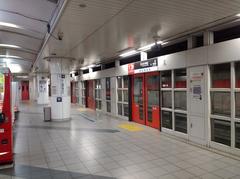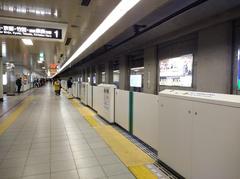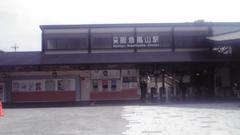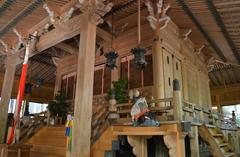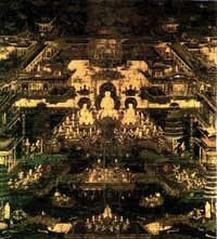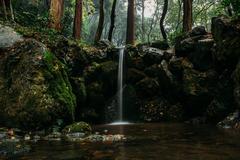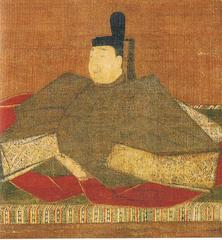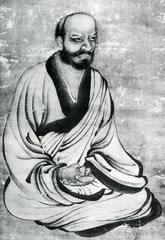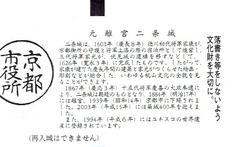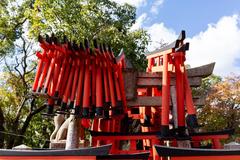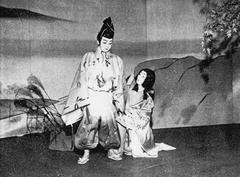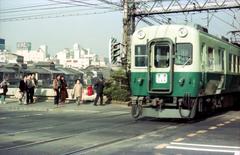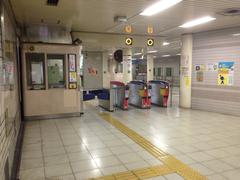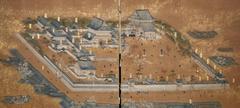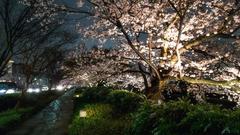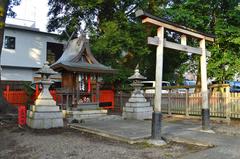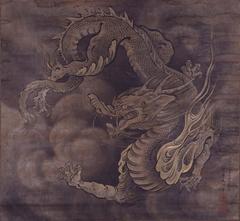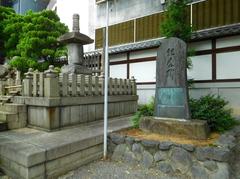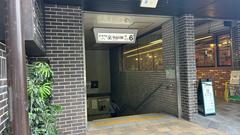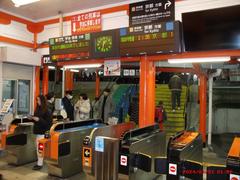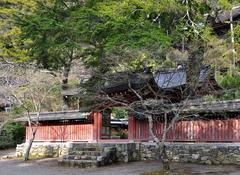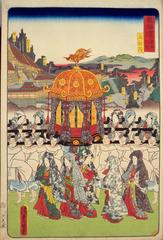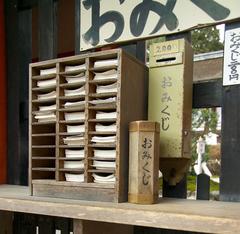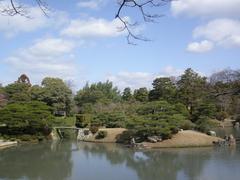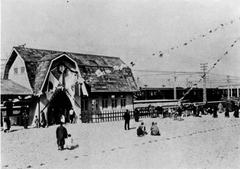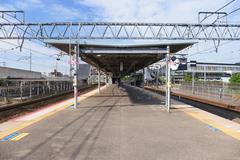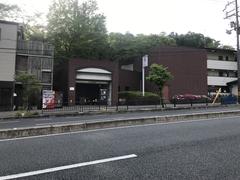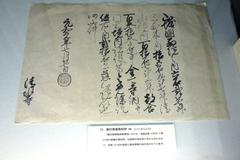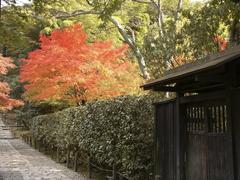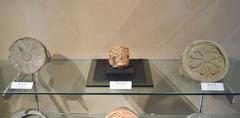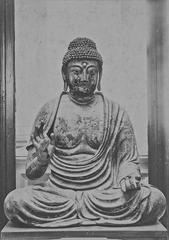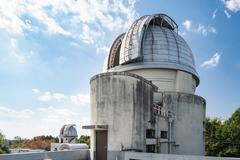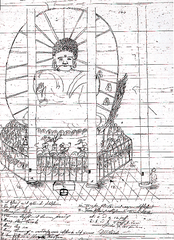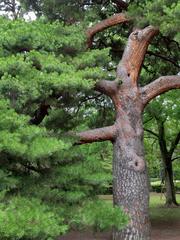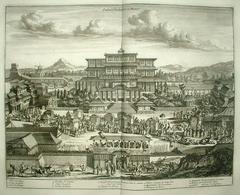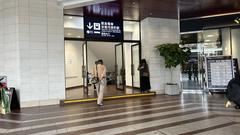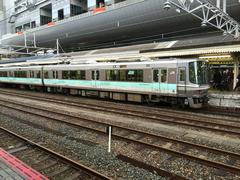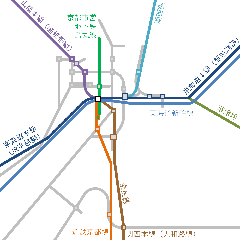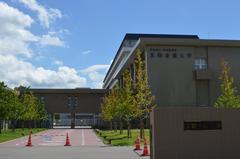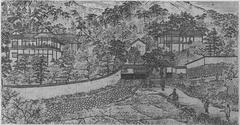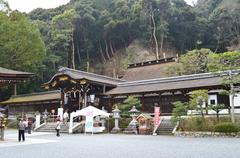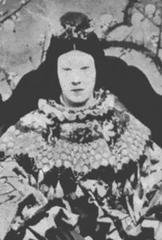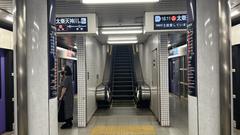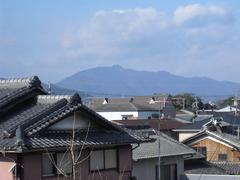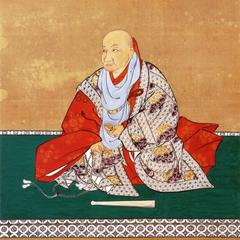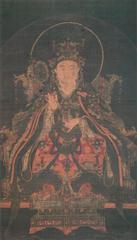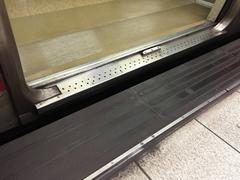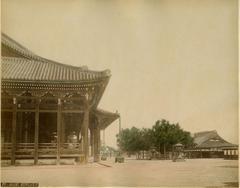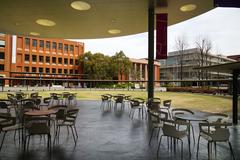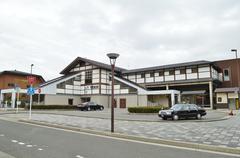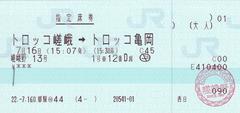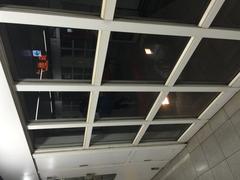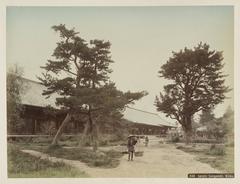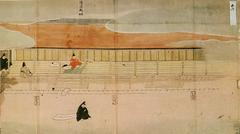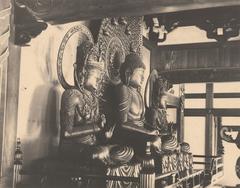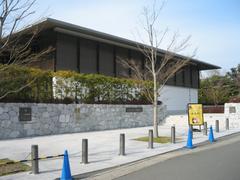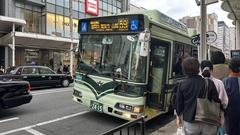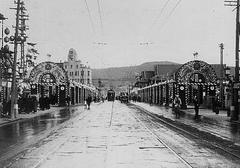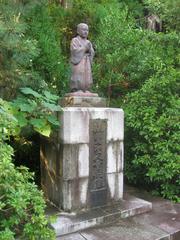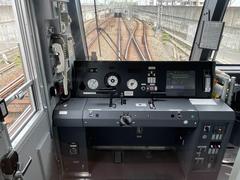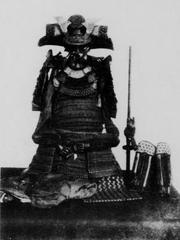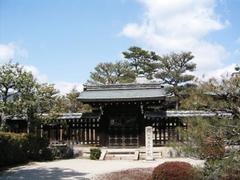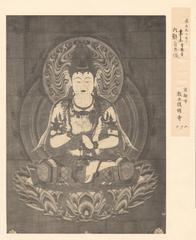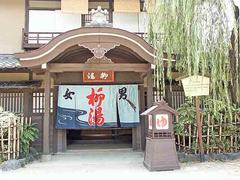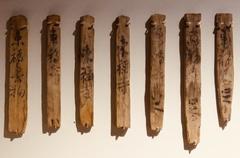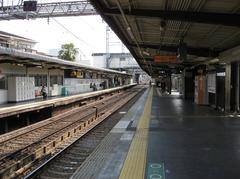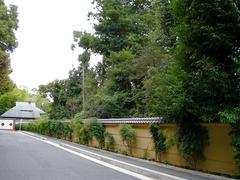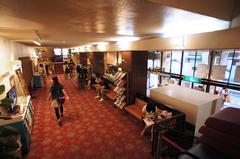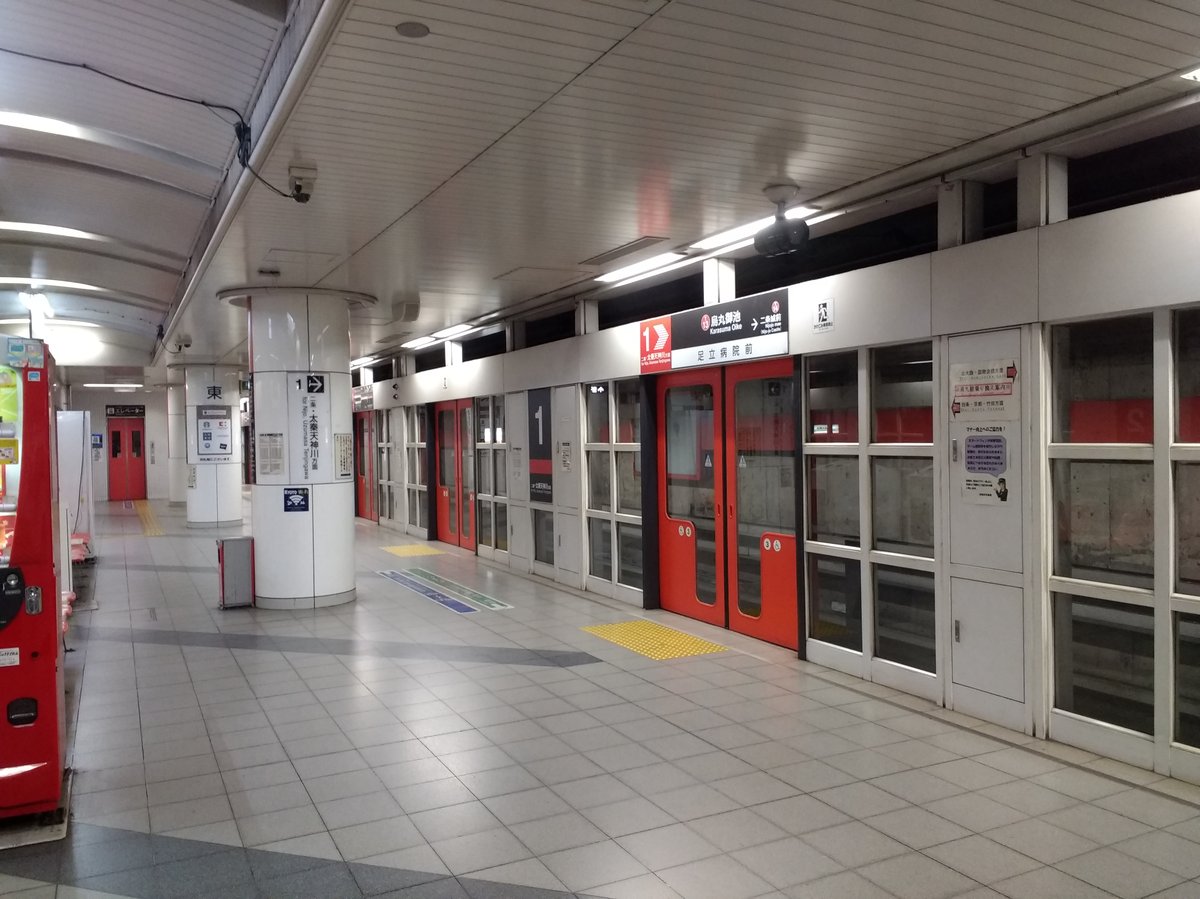
Karasuma Oike Station Kyoto: Visiting Hours, Tickets, and Tourist Guide
Date: 14/06/2025
Introduction to Karasuma Oike Station’s Importance in Kyoto
Karasuma Oike Station stands as a central pillar of Kyoto’s subway network, blending the city’s historical legacy with the efficiency of modern transit. Situated at the bustling crossroads of Karasuma-dori and Oike-dori in Nakagyo Ward, the station is not just a transportation node—it’s a gateway to the city’s most significant historic sites, vibrant neighborhoods, and contemporary attractions. Since its original opening in 1981 (as Oike Station) and subsequent transformation into a two-line interchange in 1997, Karasuma Oike has mirrored Kyoto’s evolution, linking past and present through both infrastructure and culture.
As the only subway station in Kyoto where the north-south Karasuma Line intersects with the east-west Tozai Line, Karasuma Oike serves as an indispensable transfer point, ensuring seamless travel across the city. Beyond its functional role, it offers immediate access to renowned destinations like the Kyoto International Manga Museum, The Museum of Kyoto, Rokkakudo Temple, and Nijo Castle. Seasonal highlights such as the Gion Festival and cherry blossom viewings further enhance its appeal.
This guide provides comprehensive information on Karasuma Oike Station, covering its historical significance, station layout, facilities, visiting hours, ticketing, accessibility, nearby attractions, and travel strategies. Whether you’re visiting Kyoto for the first time or returning to explore deeper, understanding Karasuma Oike Station will enrich your experience.
For more details, refer to resources like Japan Experience, Klook, and the Kyoto Station Guide.
Table of Contents
- Introduction
- Historical Background
- Visitor Information
- Station Layout and Facilities
- Major Attractions Near Karasuma Oike Station
- Cultural Highlights & Seasonal Events
- Shopping and Dining
- Accommodation and Visitor Services
- Unique Local Experiences
- Frequently Asked Questions (FAQ)
- Summary of Key Visitor Information and Tips
- Sources and Further Reading
Historical Background
Early Development
Karasuma Oike Station is strategically located at the intersection of two historic avenues in central Kyoto, reflecting the city’s grid-based design from the Heian period (794–1185). This area has long functioned as a center for administration, commerce, and culture, with close proximity to the Kyoto Imperial Palace and merchant districts (Japan Experience).
Construction and Archaeology
Construction of the Karasuma Line began in the late 1970s, with the station opening in 1981 as Oike Station. Building the subway required careful archaeological work given Kyoto’s imperial past. Artifacts discovered during construction are now displayed in the station, connecting commuters and visitors with the city’s deep-rooted history (Japan Experience).
Becoming a Major Interchange
The station was renamed Karasuma Oike Station in 1997, coinciding with the launch of the Tozai Line. This established the station as the sole intersection of Kyoto’s two subway lines, greatly boosting its role in the city’s transit system (Japanese Wiki; Wikipedia).
Urban and Architectural Transformation
The opening of the Tozai Line transformed the surrounding area into a dynamic business and cultural district with an uptick in hotels, restaurants, shops, and museums. The station itself features a multi-level layout: side platforms for the Karasuma Line beneath ticket gates, and an island platform for the Tozai Line below. Elevators, escalators, and barrier-free routes ensure ease for all travelers (Wikipedia; Japan Experience).
Cultural Significance
Adjacent landmarks include:
- The Museum of Kyoto: Housed in a historic former Bank of Japan building, it showcases the city’s history and culture.
- Kyoto International Manga Museum: A celebration of manga and pop culture, located west of the station.
- Rokkakudo (Choho-ji) Temple: The birthplace of ikebana (Japanese flower arrangement).
- Nakagyo Post Office: A national important cultural property.
- SHIN-PUH-KAN (Shinpukan): A repurposed commercial complex in the historical Kyoto Central Telephone Office.
The “Oike Station Gallery” further integrates local art and culture into the station environment (Japanese Wiki).
Visitor Information
Visiting Hours & Ticketing
- Operating Hours: Daily, from approximately 5:30 AM to midnight.
- Tickets: Fares start at about 210–220 yen, depending on distance. Tickets can be purchased at multilingual machines or via IC cards (PiTaPa, ICOCA, Suica, Pasmo).
- Tourist Passes: Options like the Kyoto Subway & Bus One-Day Pass and Kansai One Pass provide unlimited rides on designated routes.
Accessibility
The station is fully accessible, offering elevators, escalators, tactile paving, barrier-free restrooms, and accessible ticket gates. Elevators connect all levels, ensuring smooth transfers for travelers with disabilities or heavy luggage.
Transfers & Travel Tips
- Transfers: Moving between the Karasuma and Tozai Lines is straightforward, thanks to clear signage and a user-friendly multi-level design.
- Best Times to Visit: Avoid peak hours (7:30–9:00 AM, 5:00–7:00 PM) for a more relaxed experience.
- Language Support: Signage and ticket machines support multiple languages.
Station Facilities
- Restrooms: Modern, clean, and equipped with accessible and baby-care facilities.
- Coin Lockers: Located near exits and in the concourse.
- Shops & Kiosks: Offer snacks, drinks, souvenirs, and travel essentials.
- ATMs & Wi-Fi: International ATMs and free public Wi-Fi are available.
- Security: Surveillance cameras and emergency intercoms ensure safety.
Karasuma Oike Station Layout and Facilities
Karasuma Oike Station comprises several underground levels:
- Street Level: Multiple entrances/exits around Karasuma-dori and Oike-dori.
- Concourse Level: Ticketing, fare adjustment, information, shops, and access to both subway lines.
- Platform Levels: Separate island platforms for the Karasuma and Tozai Lines, with elevators/escalators linking all levels.
Other features include tactile paving for the visually impaired, wide gates for wheelchairs and luggage, and clear color-coded signage (green for Karasuma Line, vermillion for Tozai Line) to simplify navigation.
For more details, refer to Matcha’s Kyoto Subway Guide.
Major Attractions Near Karasuma Oike Station
Nijo Castle
- Access: 20-minute walk or one stop on the Tozai Line to Nijojo-mae Station.
- Hours: 8:45 AM–5:00 PM (last entry 4:00 PM), closed Tuesdays except holidays.
- Tickets: Adults ¥1,030.
- Highlights: UNESCO World Heritage Site, famed for its “nightingale floors” and beautiful gardens, especially during cherry blossom and autumn foliage seasons.
- Accessibility: Ramps and accessible paths; audio guides available.
Kyoto International Manga Museum
- Access: 10-minute walk from the station.
- Hours: 10:00 AM–6:00 PM (last entry 5:30 PM), closed Wednesdays.
- Tickets: Adults ¥800; free for children under 15.
- Highlights: 300,000+ manga items, “Wall of Manga,” workshops, and English language resources.
- Accessibility: Barrier-free, wheelchairs available.
Nishiki Market
- Access: 3-minute walk from the station.
- Hours: 9:00 AM–6:00 PM (hours vary by shop).
- Highlights: Over 130 shops offering Kyoto delicacies, street food, and local specialties.
Honno-ji Temple
- Access: 13-minute walk.
- Hours: 9:00 AM–5:00 PM, year-round.
- Tickets: Free.
- Highlights: Historic site of the Honno-ji Incident (1582), serene grounds.
Rokkaku-do (Shiunzan Choho-ji) Temple
- Access: Within walking distance.
- Hours: 8:00 AM–5:00 PM.
- Tickets: Free.
- Highlights: Birthplace of ikebana, unique hexagonal hall, ikebana lessons.
Ippodo Tea Shop
- Access: About 1.5 km on Teramachi Street.
- Hours: 10:00 AM–6:00 PM, closed Sundays.
- Highlights: Renowned for matcha and traditional teas, with occasional brewing classes.
KyoARUKI Kimono Experience
- Access: 2-minute walk from Karasuma Station.
- Hours: 9:00 AM–7:00 PM.
- Service: Kimono rentals, easy hotel returns, perfect for exploring Kyoto in style.
Cultural Highlights & Seasonal Events
Gion Festival
Held every July, the Gion Festival features grand float processions on Oike-dori Avenue, which is easily accessible from Karasuma Oike Station. The festival includes traditional music, parades, and street food.
Other Events
Seasonal highlights include cherry blossom viewings in spring and autumn foliage festivals. The Kyoto Cultural Museum, near the station, offers rotating exhibitions and craft workshops.
Kamo River Promenade
A short walk from the station, the Kamo River is a popular spot for walking, cycling, and summer riverside dining.
Shopping and Dining
The area around Karasuma Oike boasts diverse restaurants and cafés. Enjoy Kyoto specialties like yudofu, kaiseki, wagashi, seasonal fruit parfaits, and matcha sweets. Convenience stores and international eateries ensure options for all tastes and budgets.
Accommodation and Visitor Services
Karasuma Oike hosts a range of accommodations, from business hotels and apartments to international brands like Hilton Kyoto and Tokyu Stay, all with convenient subway access. Multiple bus routes and a Limousine Bus stop at Exit 3 connect travelers to key sites and Kansai International Airport.
Unique Local Experiences
- Ikebana at Rokkaku-do: Participate in traditional flower arrangement lessons at the birthplace of the Ikenobo school.
- Riverside Dining: Sample Kyoto cuisine and sake at Kamo River’s riverside izakaya, especially vibrant at night.
Frequently Asked Questions (FAQ)
Q: What are Karasuma Oike Station’s operating hours?
A: Approximately 5:30 AM to midnight.
Q: How do I transfer between subway lines?
A: Easy transfers via escalators/elevators and clear signage within the station.
Q: Are facilities accessible for disabled visitors?
A: Yes, with elevators, tactile paving, and barrier-free restrooms.
Q: How do I reach major attractions from the station?
A: Landmarks like Nijo Castle, Kyoto International Manga Museum, and Nishiki Market are within walking distance or one subway stop.
Q: Can I use IC cards for subway and buses?
A: Yes, cards like ICOCA, Suica, and Pasmo are accepted across Kyoto’s transit system.
Q: How do I get to Karasuma Oike from Kansai International Airport?
A: Use the Limousine Bus service stopping at Exit 3 for direct access.
Summary of Key Visitor Information and Tips
- Location: Central Nakagyo Ward, intersection of Karasuma and Oike streets.
- Transit: Interchange for Karasuma (north-south) and Tozai (east-west) subway lines.
- Accessibility: Fully accessible station with elevators, tactile paving, and barrier-free facilities.
- Amenities: Coin lockers, shops, ATMs, free Wi-Fi, and tourist support.
- Tickets: Single fares, IC cards, and tourist passes available.
- Nearby: Walk to Nijo Castle, Manga Museum, Nishiki Market, and more.
- Travel Tips: Avoid rush hours, use IC cards, and download navigation apps for a seamless experience.
Karasuma Oike Station is the ideal starting point for discovering Kyoto’s historic sites, cultural experiences, and culinary delights. Plan ahead and make the most of your Kyoto adventure!
